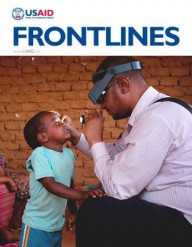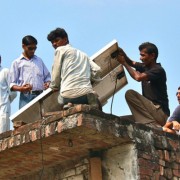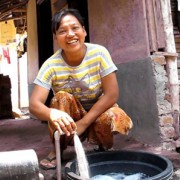 Ruksana Begum in her kitchen. Each day, she gets clean drinking water from a water purification center near her home in Bengaluru.
Neha Khator, USAID
Ruksana Begum in her kitchen. Each day, she gets clean drinking water from a water purification center near her home in Bengaluru.
Neha Khator, USAID
 Ruksana Begum in her kitchen. Each day, she gets clean drinking water from a water purification center near her home in Bengaluru.
Neha Khator, USAID
Ruksana Begum in her kitchen. Each day, she gets clean drinking water from a water purification center near her home in Bengaluru.
Neha Khator, USAID
For Ruksana Begum, the 1-kilometer-long walk to the nearby water purification center has now become worth her children’s lives.
Each morning as the clock strikes 10, Begum leaves her home carrying an empty 20-liter water can and a 5 rupee coin (8 cents) in her hand. As she arrives at the water center, she patiently waits in the queue to fill her can. Before leaving, Begum hands over the coin to Shiva, the revenue collector at the water center, and then walks back home with the filled water can, her eyes gleaming with a smile that’s hard to ignore.
“Each time I carry home a can of clean water with me, I know I’m taking back a safer and healthier life for my children,” says the proud mother of four.
It’s a complete turnaround for Begum’s neighborhood water supply, which two years ago was occasionally black and dotted with worms.
To help women like Begum get access to safe drinking water, USAID partnered with WaterHealth India, a social sector organization, to set up low-cost, community-based water purification centers in her Bengaluru neighborhood in 2015. USAID is also working with government leaders and key public and private stakeholders in India on this project to extend water and sanitation services to low-income urban populations.
“The city municipal body, Bruhat Bengaluru Mahanagara Palike (BBMP), provided us with land, a raw water connection and electricity supply free of charge to set up the water treatment center,” says Vikas Shah, chief operating officer of WaterHealth India.
Built in a 50-square-foot area, the water center opens at 6 in the morning and runs non-stop until 8 at night to fill around 350 water cans per day. Each can covers the drinking and cooking needs of a four-member family for three days, proving to be a lifesaver.
In the city of Bengaluru, India’s information technology hub, deaths due to waterborne diseases are nothing new. Over 72 percent of Bengaluru’s groundwater is contaminated with toxins above permissible levels, a problem widespread in South Asia where over 700 million people still lack access to safe drinking water.
In Lingarajpuram, the slum within Bengaluru where Begum lives in her one-bedroom house, the struggle for clean drinking water is similar to that faced by the rest of the city. The water that flows from the taps typically is yellow.
“It’s unclean bore well water and is polluted and poisonous. In the rainy season, even mud would mix in the water. On top of that, such filthy water is supplied to our homes for only two to three hours once in every three days,” laments Begum. “Even though I used to boil and filter the water, it never seemed to lose its yellow color.”
While Begum’s children often complained of fever and had to miss school after drinking water from the tap, she and her husband experienced severe joint pain. “There were days when I couldn’t even pick up a blanket, let alone do household chores,” she says.
For Begum’s husband, who is a daily wage laborer, missing a day at work meant losing 750 rupees ($12) per day. “That’s a lot of money considering that a visit to the doctor and paying for the medicines costs 500 rupees ($8),” she adds.
Like others in her neighborhood, Begum had made her peace with the water crisis until one day two years ago when worms appeared in the water. “I opened the tap one day and the water was black in color. I could even see worms in that water. When I inquired, I came to know that the drain water pipe had burst and was mixing into the drinking water. That was the day I had enough. I couldn’t see my family drinking this,” she said.
From Worms to State-of-the-Art
Inside the WaterHealth Center, a state-of-the-art, six-stage purification system converts raw groundwater into clean drinkable water that meets and even exceeds the World Health Organization’s global standards.
Each center is managed by an operator, a quality checker, a revenue collector and a sales person, all recruited locally from the neighborhood and trained by WaterHealth India. “The center is not only a sustainable source of safe water but of employment as well,” says Shah.
So far, USAID and the city municipal body have established nine water centers across Bengaluru that have linked 11,250 poor households to a sustainable source of clean water. There are plans to set up 16 more in 2016 to reach 20,000 more households.
In Lingarajpuram, over 100 families procure their drinking water from the four faucets outside the center.
“My 4-year-old daughter used to run a high fever and would shiver after drinking from the tap. A local doctor advised that we buy bottled water from the retail market. But they are expensive (30 rupees for a 20-liter can),” says 24-year-old Y. Thyamma, a resident of Lingarajpuram. “Since the water center has opened, I’m now able to purchase clean water at just one-sixth the cost (5 rupees for 20 liters),” she adds.
Says WaterHealth’s Shah: “Drinking water solutions exist in Bengaluru but they are neither safe nor affordable. With the establishment of the 25 WaterHealth Centers, over 31,000 households will gain access to safe drinking water, transforming underserved communities by improving family health, work attendance, reducing school absenteeism, and improving the overall quality of life.”
The water center eventually will be handed over to the city municipal body, which in turn plans to replicate this innovative model across the entire city to provide safe drinking water to Bengaluru’s population of 4.1 million. When asked if the water center will continue to receive the same support from the community once it is fully owned by the government, Shah pointed toward Shashi Kala, a 50-year-old grandmother and resident of Lingarajpuram.
Kala and her family members take turns going to the water center. She, her son and her daughter-in-law no longer complain of dysentery since they began drinking the clean water, and she says her trips to the center have been nothing but an enlightening experience.
“Till now, I used to believe that clean drinking water for the poor is a privilege,” Kala said. “Just like good clothes and good food, we must spend if we want to drink clean water. But after coming here at the water center, I have realized that safe drinking water is not a privilege but my right, and it’s affordable for people like me.”















Comment
Make a general inquiry or suggest an improvement.